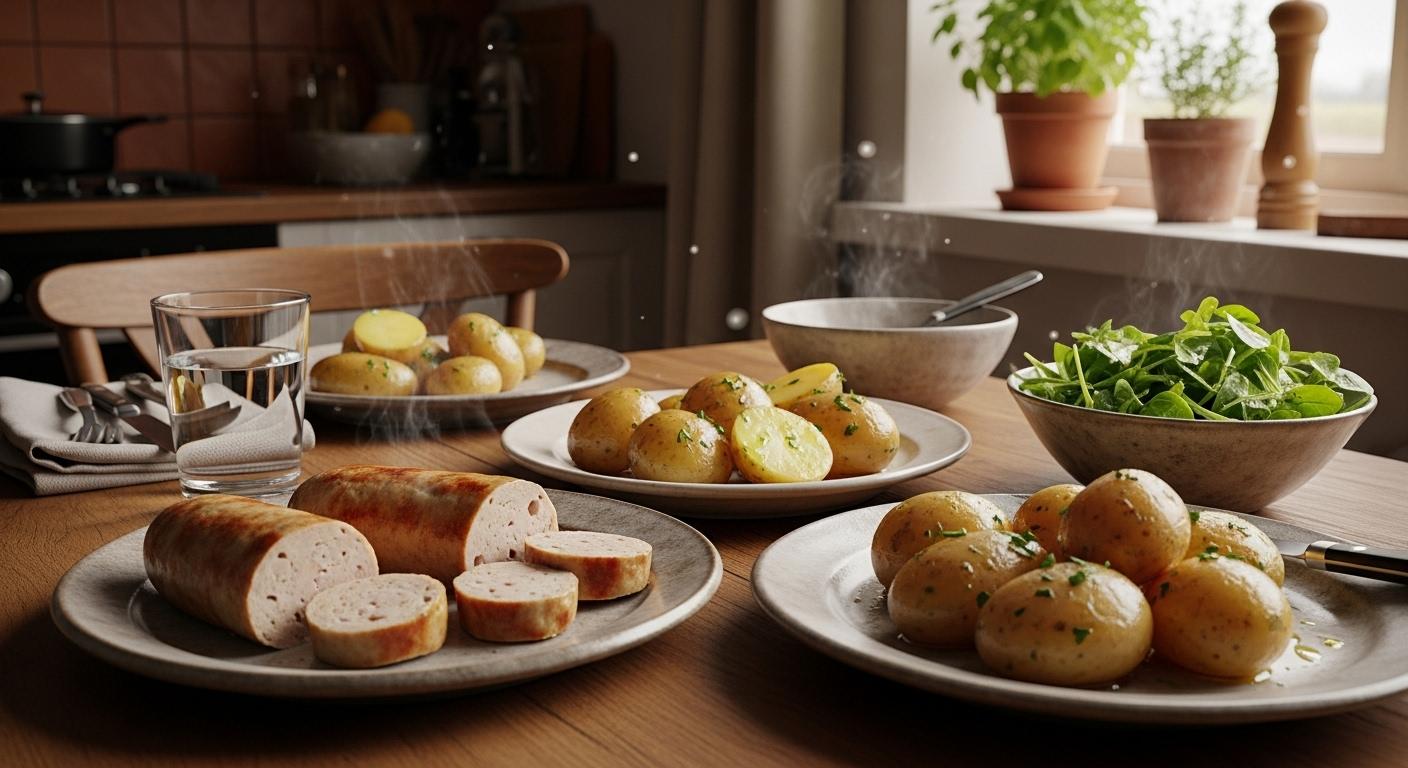Wondering whether a breakfast favorite can stay on the plate without stress, especially with that search term white pudding pregnant echoing in your mind. You want flavor, comfort, and safety in the same bite. You also want clear answers, not guesswork. Here is the short path to calm. If white pudding is cooked through and served steaming hot, it can fit a pregnancy meal plan. If it is cold, lukewarm, or deli sliced, skip it. Temperatures tell the truth, not color or crispiness. Storage habits matter more than we think. Labels too, especially for liver content, salt and allergens. We will unpack safety, cooking temperatures, storage, ingredients, and practical choices that respect your preferences and your time.
What exactly is white pudding
White pudding has two main families, both blood free, both satisfying, yet quite different on the spoon.
- Irish or Scottish style, a sausage that usually blends oats or barley with pork fat, gentle spices, and sometimes minced pork. Texture can be crumbly and rich.
- French style boudin blanc, a delicate emulsion made from bread and milk with white meats, sometimes egg and cream, often very soft and mild.
Recipes vary in grain choice, meat ratio, spice profile, and fat content. That variation influences nutrition, flavor, and, importantly, cooking time. If you searched white pudding pregnant because you want a simple yes or no, here is the essence, cook it fully, serve it hot, and keep storage tight.
White pudding pregnant, is it safe and when
Safety hangs on three pillars, temperature, handling, and time. Fresh sausages that start raw need a core target of 67 to 70°C. Leftovers need a higher target, internal temperature 74°C / 165°F until visibly steaming. A piping hot center is your green light. A warm edge with a cool center means wait, keep heating.
- If the pack says ready to eat, pregnancy still adds a layer of caution. Reheat until the center is hot, not just the surface.
- If the product was sliced at a deli counter or sat on a buffet, do not eat it cold. Heat it thoroughly or choose something else.
Many parents land on white pudding pregnant because they want one rule to remember. Try this one, heat beats doubt.
Ingredients, labels, and what to scan fast
You know your body and your preferences. White pudding can include milk, egg, wheat via bread or cereals, and sometimes soy. Check the allergen box and the full ingredient list. If the product mentions liver or offal, consider your vitamin A intake. Preformed vitamin A, called retinol, accumulates. Occasional small portions might be fine, frequent liver based products can push intake high.
- Check salt level. If you are managing blood pressure or fluid retention, pick lower salt choices.
- Some producers use nitrates and nitrites to preserve color and inhibit bacteria. If you prefer nitrite free, scan for it on the label.
- Look for claims like low sodium variants or no artificial preservatives if these matter to you.
Pathogens and risk, what the science says
Three names carry the most practical weight here, Listeria monocytogenes, Salmonella, and Toxoplasma gondii. Each behaves differently.
- Listeria thrives even in the fridge. This is why cold ready to eat meats can be risky in pregnancy, especially if kept too long or handled frequently. Heating to steaming kills it. If you experience fever, chills, muscle aches, or gastrointestinal upset after a suspect meal, call your clinician. Treatment, when needed, may involve antibiotics such as amoxicillin, guided by your care team.
- Salmonella usually comes from raw egg or undercooked meat. Onset often arrives within hours to two days, with diarrhea, vomiting, and fever. Thorough cooking is strongly protective. Hydration is the first step if symptoms occur, seek medical review if severe.
- Toxoplasma gondii is mainly linked to undercooked meat and cross contamination. If your toxoplasmosis serology is negative, meaning no immunity, stick to the temperature rules and keep raw and cooked tools separate. If infection is suspected early in pregnancy, clinicians may consider spiramycin, and if fetal infection is confirmed, combinations such as pyrimethamine with sulfadiazine plus folinic acid can be discussed under specialist guidance.
You might be thinking, white pudding pregnant is not steak tartare, why the fuss. Because sausage mixtures vary and dense products can hide cooler pockets. A thermometer is not overkill, it is reassurance.
Temperatures and cooking that work every time
Heat is the most reliable control. The numbers are not arbitrary, they reflect the temperatures that reduce pathogen survival.
- Fresh or raw white pudding, aim for 67 to 70°C at the center.
- Leftovers, reach 74°C, and keep it there briefly, the surface should release steam.
Methods that fit a busy kitchen:
- Oven baking at 180°C, about 20 to 30 minutes for a 150 to 200 g sausage, flip once, verify the center. Carryover heat continues for a couple of minutes after you remove it from the oven.
- Pan cooking on medium heat, turn often, brown the outside, then check the center temperature. Browning is not the same as safe, the probe tells the truth.
- Foil wrap or papillote can work, just confirm the core temperature.
- Use thermometer guidance for sausages to avoid guesswork.
When the internet suggests white pudding pregnant hacks, the consistent winner is a thermometer and patience.
Storage, packaging, and shopping choices
Cold control matters. Keep the fridge between 0 and 4°C, see it as a holding zone, not a long term safety net. Once opened, consume promptly, ideally within one to two days.
- Always refrigerate below 4°C (40°F).
- Respect use by date guidance, do not stretch it.
- Prefer sealed, pre packaged products from producers that state cooking instructions and storage clearly.
- If freezing, label the date, choose airtight packaging, and think freezing for long term storage as a quality tool, not a license to forget the item for months.
- Thaw gently in the fridge, not on the counter, or use the microwave defrost and cook immediately after, as in thaw in fridge, not counter.
If you are scanning a label with the phrase white pudding pregnant in mind, check storage conditions, ingredients, and whether the casing is intact. Skip any swollen or damaged packs.
Handling and kitchen hygiene made practical
Simple habits block microbial shortcuts.
- Keep raw and cooked tools apart, boards, knives, plates.
- Wash hands before and after handling raw meat.
- Clean surfaces with hot soapy water, rinse, dry.
- Do not leave cooked foods out for more than two hours, or one hour if room temperature is above 32°C or 90°F.
- Reheat leftovers once only, until they are visibly steaming, as in reheat leftovers to steaming hot.
Think of white pudding pregnant safety as a rhythm, cold storage, clean prep, hot finish, prompt serving.
Allergens, additives, and vitamin A in plain terms
Label scanning can feel like reading a new language. A few shortcuts help.
- Milk, egg, and gluten are common in both styles. Gluten free versions exist, check that the cereal is oats certified gluten free, and that cross contact is managed.
- Pork is standard, though poultry based boudin blanc variants occur. Allergen statements help, look for allergen labeling that is clear and specific.
- Salt content varies a lot. Consider your total daily intake.
- If you are watching vitamin A intake, avoid products listing liver or offal. Retinol is the form that accumulates in the body.
Nutrition snapshot and portions that feel right
Exact numbers depend on the recipe, the fat and cereal ratio, and the water content. A single slice of Irish or Scottish style white pudding, often 50 to 60 g, can deliver roughly 180 to 230 kcal, 7 to 10 g protein, 12 to 18 g fat, 6 to 12 g carbohydrate, and 200 to 350 mg sodium. Boudin blanc style per 100 g commonly offers around 9 to 13 g protein, 15 to 25 g fat, 5 to 12 g carbohydrate, and 1.5 to 2.2 g salt. Many products also contribute iron, zinc, and vitamin B12 presence.
Practical pairing, balance it with vegetables rich in fiber, whole grains, and a fresh fruit. If reflux is an issue, smaller portions and baking instead of heavy pan frying may reduce symptoms.
Eating out, takeaways, and buffets without the guesswork
At a cafe or a market stall, ask for white pudding cooked to order and served hot throughout. If the item looks like it has been sitting out, or you are told it is warmed rather than cooked through, choose another option. Busy vendors who cook to order and keep their tools clean are a safer bet.
If your mind circles back to white pudding pregnant while scanning a brunch menu, ask a simple question, can you cook this until the center is hot and serve it right away.
When to skip and what if symptoms appear
You might love a traditional Ulster breakfast. You might love boudin blanc with apple. Some days the safest choice is to wait.
- Skip it if you cannot ensure proper cooking or if the cold chain has been broken.
- Avoid if the packaging is swollen or the date has passed.
- If your toxoplasmosis serology is negative and you cannot verify cooking, skip that serving.
After a risky bite, watch for foodborne illness symptoms to monitor, such as fever, chills, persistent vomiting, severe diarrhea, abdominal cramps, headache, or tender lymph nodes. Save the packaging, note purchase date and place, hydrate, and seek care if unwell. If you are reading about white pudding pregnant because you feel unwell, do not wait to ask for help.
Simple pregnancy safe ways to cook white pudding
- Oven baked at 180°C, pierce the casing lightly if needed, bake 20 to 30 minutes depending on size, confirm 67 to 70°C at the core.
- Pan cooked on medium heat, turn often, brown outside, confirm the center.
- Gentle foil parcel, fine if you verify the center temperature.
- Leftovers, reheat once to 74°C, serve immediately.
White pudding pregnant cooks often report the same outcome with these methods, a crisp exterior and a safe, hot center.
Choosing products with confidence
A few cues help you feel calm at the shelf.
- Prefer sealed packs from reputable producers with clear cooking guidance.
- Check batch or lot number, storage conditions, and portion suggestions.
- For traditional breakfasts like an Ulster fry components plate, buy the white pudding in sealed packs and cook it fresh at home.
For broader context, public health bodies like EFSA UK FSA FDA advisories on processed meats consistently reinforce the same message, avoid raw or undercooked meat in pregnancy and reheat ready to eat products until hot throughout.
Common questions parents ask
- Is white pudding safe in pregnancy. Yes, when cooked to the proper temperature and handled safely.
- Do I have to avoid all processed meats. No, heating removes most risk for many products.
- How do I tell if it is done. A probe in the center is best, color misleads.
- What about nitrites. Some families prefer nitrite free, others prioritize taste. Choose what fits your values and health goals.
- How often can I eat it. Keep portions moderate and vary your proteins through the week.
If you keep circling back to white pudding pregnant, you are simply doing what careful parents do, checking and choosing.
Safer swaps and easy alternatives
- Roast poultry cooked until the center reaches the target temperature
- Homemade baked nuggets
- Oven baked fish with a verified internal temperature
- Eggs cooked until the yolk and white are firm
- Legumes, tofu, and tempeh for plant based protein
- Whole grain sides and colorful vegetables to balance salt and fat
These choices make temperature control straightforward and reduce overall sodium and saturated fat.
Key takeaways
- White pudding can fit a pregnancy meal plan when it is fully cooked and served hot throughout.
- Fresh products, aim for 67 to 70°C at the center. Leftovers, reheat to 74°C. A thermometer adds confidence.
- Keep the fridge between 0 and 4°C, respect dates, consume quickly after opening, cool leftovers fast, and reheat once only.
- Scan labels for allergens, salt, and liver or offal if you are limiting vitamin A. Select nitrite free options if that aligns with your preferences.
- Stay alert to Listeria, Salmonella, and Toxoplasma. Heating and careful handling reduce risk.
- For dining out or takeaways, ask for cooking to order and serve hot. Skip cold deli slices or buffet trays.
- Use the search term white pudding pregnant as your reminder, cook it hot, store it cold, serve it fresh, and you are on the safest path.
If questions persist or symptoms arise, reach out to your midwife, obstetrician, or primary care clinician. For ongoing support, practical checklists, and tailored tips, download the application Heloa for personalized guidance and free health questionnaires for children.
Questions Parents Ask
Can I eat white pudding in pregnancy (NHS advice)?
Yes — many health services, including NHS guidance, allow white pudding during pregnancy when it is heated until steaming throughout. The key point is whether the product is ready-to-eat cold or needs cooking. If it’s raw, make sure it’s cooked through; if it’s sold as ready-to-eat, reheat until piping hot before eating. Also keep an eye on labels for liver (vitamin A) and high salt. If you feel unsure, your midwife or GP can reassure you based on your personal circumstances.
Is it safe to eat deli‑sliced white pudding?
Cold deli slices carry a higher listeria risk because the bacteria can survive refrigeration. If the white pudding has been sliced and kept cold, avoid eating it without reheating until it is steaming hot. If a café or vendor cooks it to order and serves it hot, that’s a safer choice. When buying prepacked sealed portions, follow the use‑by date and reheat thoroughly if in doubt.
How often can I eat white pudding while pregnant?
There’s no strict ban, but moderation is wise. Because white pudding can be relatively high in salt, saturated fat and sometimes preservatives, treating it as an occasional choice — for example a serving once or twice a week rather than daily — helps balance overall nutrition. Swap in lower‑salt or lean protein meals on other days, and avoid frequent liver‑containing products to limit preformed vitamin A. If you have specific health concerns (blood pressure, gestational diabetes), ask your care team for personalised advice.

Further reading:









